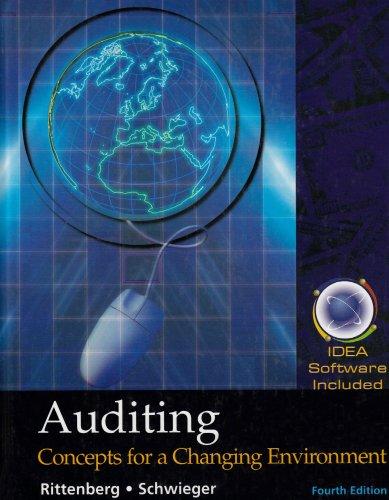Question
1. The weights used in the WACC should be: a. Based on book value. b. At the current capital structure when valuing a minority interest.
1. The weights used in the WACC should be:
a. Based on book value.
b. At the current capital structure when valuing a minority interest.
c. At the optimal capital structure when valuing a minority interest.
d. Based on market values.
2. In computing equity returns, which factors are common to both the Capital Asset Pricing Model and the Build-up Model?
a. Risk-free rate, equity risk premium, beta.
b. Equity risk premium, beta, small stock premium.
c. Risk-free rate, specific company risk, small stock premium .
d. Beta, equity risk premium, small stock premium.
3. The primary difference between a discount rate and a capitalization rate is:
a. Growth.
b. Cash flow vs. earnings.
c. Minority vs. control.
d. Pretax vs. after-tax earnings.
4. Discount rates are typically:
a. Based on "real" terms.
b. Based on "nominal" terms.
c. Reasonable for up to one year.
d. Reasonable for more than one year
5. Which of the following is not an assumption under the CAPM?
a. Diversified portfolio.
b. There are no taxes.
c. Investors are risk-adverse.
d. Different holding periods
6. Capitalization and discount rates are always on a:
a. Control basis.
b. Minority basis.
c. Marketable basis.
d. Non-marketable basis.
7. The Build-up model of developing a discount rate is most often used when valuing the following types of companies:
a. Small public companies.
b. Small private companies.
c. Large public companies
d. Large private companies
8. The following is true concerning capitalization rates:
a. They are easily determined
b. There is one most generally accepted method to determine capitalization rates
c. The capitalization rate must be consistent with the type of income being capitalized
d. None of the above
9. Beta is:
a. The squared deviation of the actual return of an investment
b. The risk premium of the stock market
c. A measure of an investment's volatility
d. The rate of return on a risky investment
10. Which of the following is a correct statement about the relationship between discount rate and capitalization rate in the context of the income approach to valuation?
a. The terms discount rate and capitalization rate are used interchangeably to mean the same thing
b. The discount rate equals the capitalization rate less the long-term sustainable growth in the variable being discounted or capitalized
c. The capitalization rate equals the discount rate less the long-term sustainable growth in the variable being discounted or capitalized
d. None of the above is a correct statement
11. Cost of capital is properly equated to which of the following?
a. The discount rate
b. The discount rate plus the growth rate
c. The capitalization rate
d. The capitalization rate less the growth rate
12. When using the CAPM, beta is a measure of:
a. Specific company risk
b. Systematic risk
c. Unsystematic risk
d. All of the above
13. When using the WACC and CAPM:
a. The amount of debt should not influence the equity return
b. The debt/equity structure is always determined using public company capital structures
c. Beta should be relevered to the assumed capital structure
d. A beta above 1.5 indicates that the debt percentage is too high
14. When using the adjusted net assets method, the analyst can adjust the book value to:
a. Fair market value
b. Replacement value
c. Liquidation value
d. All of the above
e. None of the above
15. The Capitalization of the Earnings Method would be a good method to use when valuing:
a. An accounting practice
b. A large manufacturing company
c. A wholesale auto parts distribution center
d. All of the above
e. None of the above
16. Company X has a 5-year weighted average income of 15,000,000. There are 1,000,000 shares of capital stock outstanding which is selling currently for $75.00 per share. The PIE ration is:
a. 15
b. 5
c. 20
d. All of the above
e. None of the above
17. Wings Company has a 5-year weighted average profits of $120,000. The weighted average dividend payout over this same period of time is 25%. The weighted average dividend yield rate of 5 comparable companies is 8%. What is the value of the company?
a. 960,000
b. 1,500,000
c. 375,000
d. All of the above
e. None of the above
Step by Step Solution
There are 3 Steps involved in it
Step: 1

Get Instant Access to Expert-Tailored Solutions
See step-by-step solutions with expert insights and AI powered tools for academic success
Step: 2

Step: 3

Ace Your Homework with AI
Get the answers you need in no time with our AI-driven, step-by-step assistance
Get Started


